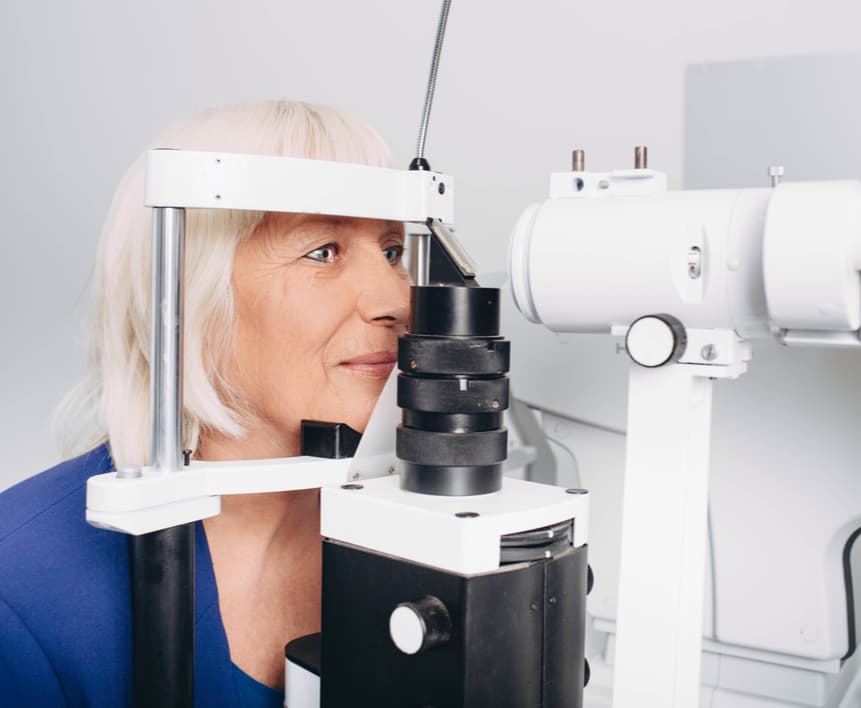Symptoms of Dry Eyes
Dry eyes occur when there is not adequate lubrication on the surface of the eye. Studies estimate that the number of Americans who suffer from this condition is more than 16 million.1 Anyone can have occasional dry eyes, but dry eye syndrome is characterized by frequent or severe dry eyes. If you suffer from frequent dry eyes, you may have dry eye syndrome. Some of the symptoms of dry eyes include:
- Redness
- A burning or stinging sensation
- Itchy Eyes
- Watery eyes (excessive tearing as an overcompensation for dryness)
- Eyes that feel fatigued or tired
- Blurry vision
- Sensitivity to light
- Difficulty seeing at night
- Stringy eye discharge
Types of Dry Eye Disease
Dry eye disease is categorized into two different types:
- Aqueous Tear Deficiency (ATD) is a type of dry eye disease that happens when your body does not produce enough tears.
- Evaporative Dry Eye is the more common type of dry eye disease and it occurs due to a tear film dysfunction, meaning that the quality of the tears produced is poor.

Meibomian Gland Dysfunction (MGD)
Evaporative dry eye is often caused by an underlying condition called Meibomian Gland Dysfunction or MGD. Your eyelids have tiny glands that produce lubricating oils to keep your eyes moisturized and prevent tear evaporation. If these glands, called Meibomian glands, become blocked, it can cause dry eye syndrome.
Common Dry Eye Syndrome Symptoms
If you suffer from frequent dry eyes, you may have dry eye syndrome. Some of the symptoms of dry eyes include:2
- Redness
- A burning or stinging sensation
- Itchy eyes
- Watery eyes (excessive tearing as an overcompensation for dryness)
- Eyes that feel fatigued or tired
- Blurry vision
- Sensitivity to light
- Difficulty seeing at night
- Stringy eye discharge

Causes of Dry Eyes
There is not one singular cause of dry eyes, and this irritating condition can affect anyone. Some risk factors that can increase the likelihood of dry eye symptoms include:3
- More than 2 hours per day of screen time
- Aging—dry eyes occur more frequently over age 50
- Environmental factors, such as dry and windy weather
- Contact lenses
- Hormonal changes, including menopause
- Medical conditions, including thyroid disorders, rheumatoid arthritis, Sjögren’s syndrome, autoimmune diseases, hypertension, diabetes and Meibomian gland dysfunction
- Prolonged use of certain medications, such as birth control pills, decongestants, antihistamines, diuretics, and certain antidepressants
Treatment Options for Dry Eye Syndrome
At Columbus Ophthalmology Associates, we offer several dry eye solutions. Your eye doctor will discuss your symptoms and evaluate your eyes to determine the cause of your dry eyes. They will then recommend a treatment plan based on the type and severity of your dry eyes. Your eye doctor may recommend prescription eye drops such as Restasis® (Cyclosporine) or Xiidra® (Lifitegrast). Other possible treatments include non-surgical procedures to unblock the Meibomian glands or the insertion of punctal plugs in the tear ducts to prevent tear drainage.
Learn More About Dry Eye Treament
At Columbus Ophthalmology Associates, our experts can diagnose the source of your dry eye symptoms and provide effective, lasting treatment.
Frequently Asked Questions About Dry Eye Syndrome
Will over-the-counter eye drops fix my dry eyes?
Over the counter eye drops and artificial tears can provide temporary relief. Look for formulas that do not have preservatives. However, if your frequent dry eyes are caused by MGD or poor tear production, you will need treatment from an Ophthalmologist or Optometrist who specializes in dry eye disease.
Are there any home remedies for dry eyes?
Yes, there are several things you can do to help prevent or soothe dry eyes:
- Keep the air in your home moist with a humidifier
- Use warm compresses
- Take frequent breaks when working on a computer or looking at a screen
- Take supplements that support eye health, such as Vitamin A
- Eat a diet rich in omega-3 fatty acids
Are there any long-term health risks associated with dry eye syndrome?
The biggest side effect of chronic dry eyes is a negative effect on overall quality of life. If left untreated dry eye syndrome can also cause more serious eye problems such as corneal abrasions and eye infections.


















Contact Us to Schedule a Dry Eye Exam
To request a Dry Eye exam, please complete the form below and our Dry Eye Coordinator will be in touch with you shortly.
Real Patient Reviews
4.9 Star Average on Google & Facebook
From the moment you step off the elevator you are taken aback by the impressive remodel then greeted by a friendly & professional staff member at the reception desk. My visits to COA have all been very enjoyable experiences. I really appreciate Dr. McHale’s ability to establish immediate rapport, it encourages you to relax because you know any news you receive will be honest & straight forward. Thank you Dr. McHale & COA staff for your collective effort.
Professional & courteous Staff, each step is explained to provide comfort….impressive bunch.
Dr. McHale and his staff are awesome. I couldn’t ask for a more down to earth Doctor. His staff is the nicest staff I have ever seen. 10 stars out of 5.
1 Farrand KF, Fridman M, Stillman IO, Schaumberg DA. Prevalence of Diagnosed Dry Eye Disease in the United States Among Adults Aged 18 Years and Older. Am J Ophthalmol 2017;182:90-8
2 Mayo Clinic. Dry Eyes. Available: https://www.mayoclinic.org/diseases-conditions/dry-eyes/symptoms-causes/syc-20371863. Accessed June 16, 2021
3 American Academy of Ophthalmology. What is Dry Eye? Available: https://www.aao.org/eye-health/diseases/what-is-dry-eye Accessed June 16, 2021
